Early Tourist Guidebooks to Singapore: The Handbook to Singapore (1892)
The opening of the Suez Canal in 1869 along with advances in steamships, saw a boom in travellers visiting the East. Senior Librarian Bonny Tan explores travel guides for visitors seeking a leisurely but safe journey to the mystical but demystified Far East.
— G.M. Reith, Padre in partibus, p. 1.
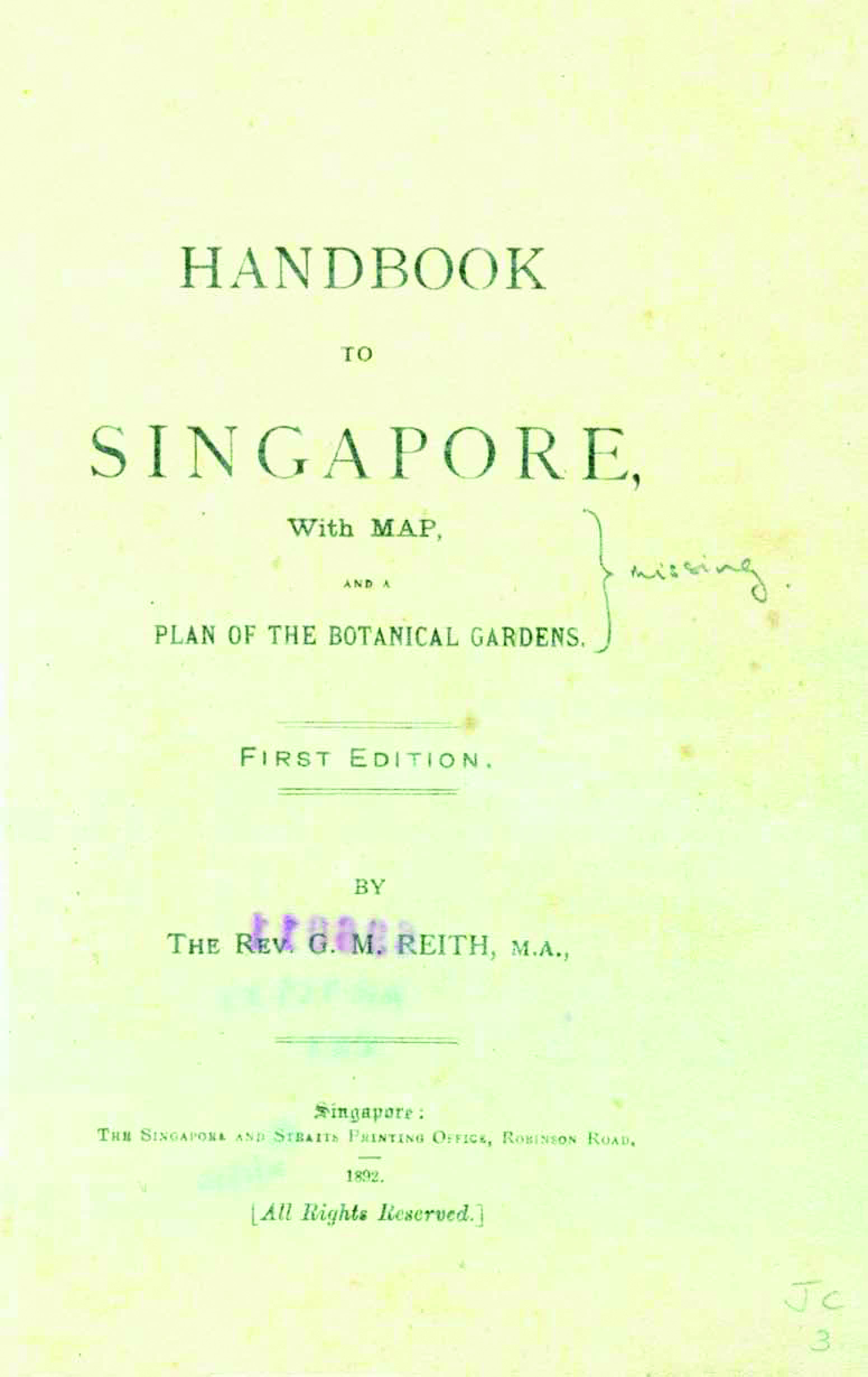
Travellers from Europe saw their journey to the East cut down by as much as half when the Suez Canal opened in 1869. Steamships, helped along with advances in their engine development, were preferred over sailing ships as they proved faster and more efficient. Beginning as mail services dispatching post, ships from companies like the Peninsular and Oriental Steam Navigation Company soon became vessels for ferrying passengers. In turn, travelogues written by the adventurous sojourner who happened to be sailor, civil servant or missionary soon evolved into travel guides published by travel companies for the paying tourist seeking a leisurely but safe journey to the mystical but demystified Far East.
A Useful Vade-Mecum
At a time when guidebooks for the Western hemisphere were being churned out by such publishers as Murray and Badaeker, Rev. George Murray Reith, resident minister of the local Presbyterian Church, took it upon himself to write a handy guide to Singapore for visitors to the town.1
This “useful vade-mecum” (Reith, 1892, p. iii), or ready reference, was designed to help visitors who had merely a few hours to a few days in the town. In contrast, earlier guides that had preceded it, namely, The Stranger’s Guide to Singapore (1890) by B.E. D’Aranjo and Picturesque and Busy Singapore (1887) by T.J. Keaghran had proved too “limited” in their “scope” (Aranjo’s) (Reith, 1892, p. iii) or “too general to be of practical value” (Keaghran’s) (Reith, 1892, p. iii).
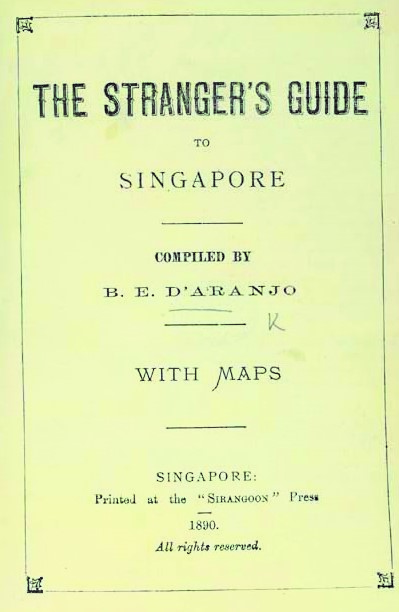
Segmented into 15 chapters, the guide starts off with a condensed historical overview of Singapore beginning with its founding in 1819 by Stamford Raffles2 and giving insightful details of events prior to 1900. Reith’s historical overview is based on Buckley’s articles in the Singapore Free Press entitled Anecdotal History of Singapore which was to be published as an important text on Singapore’s history.
Descriptions of the Environs
Following this is a general description of the town and its environs, walking tours or drives, descriptions of buildings and landmarks as well as places of worship and hospitals. Reith does not merely describe landscape and landmark, but waxes lyrical over scenery and the island’s natural beauty. For example in describing the approach to Singapore from the west, he notes:
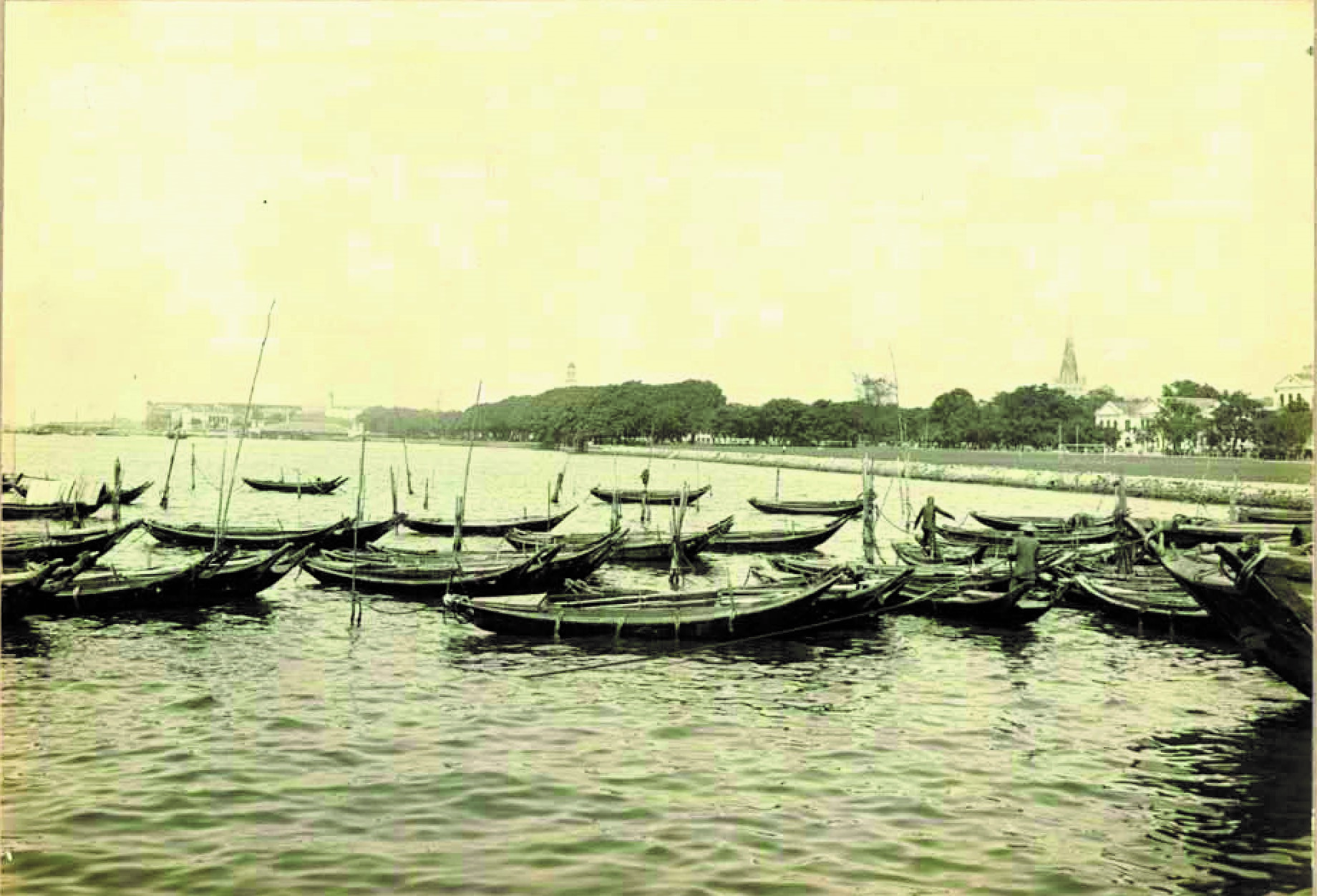
He highlights details which set off the unusual beauty surrounding the island. For example, in the same passage he points to a common optical illusion in which the distant southern islands seem to be suspended above the sea.
In Chapter Four, he gives directions for four tours around and beyond the town, each one accommodating a tourist’s length of stay which could vary from a few hours to half a day. The tours skirt around the wharves through the town to locations such as the Botanical Gardens, the Impounding Reservoir (MacRitchie Reservoir), a climb up Mount Faber, and a carriage ride to Johor Bahru. In delineating the journeys, Reith also paints a three-dimensional picture of Singapore town in the late 19th century, highlighting familiar locations and landmarks now long forgotten, and capturing the leisurely lifestyle of the expatriate along with the labouring duties of the natives.
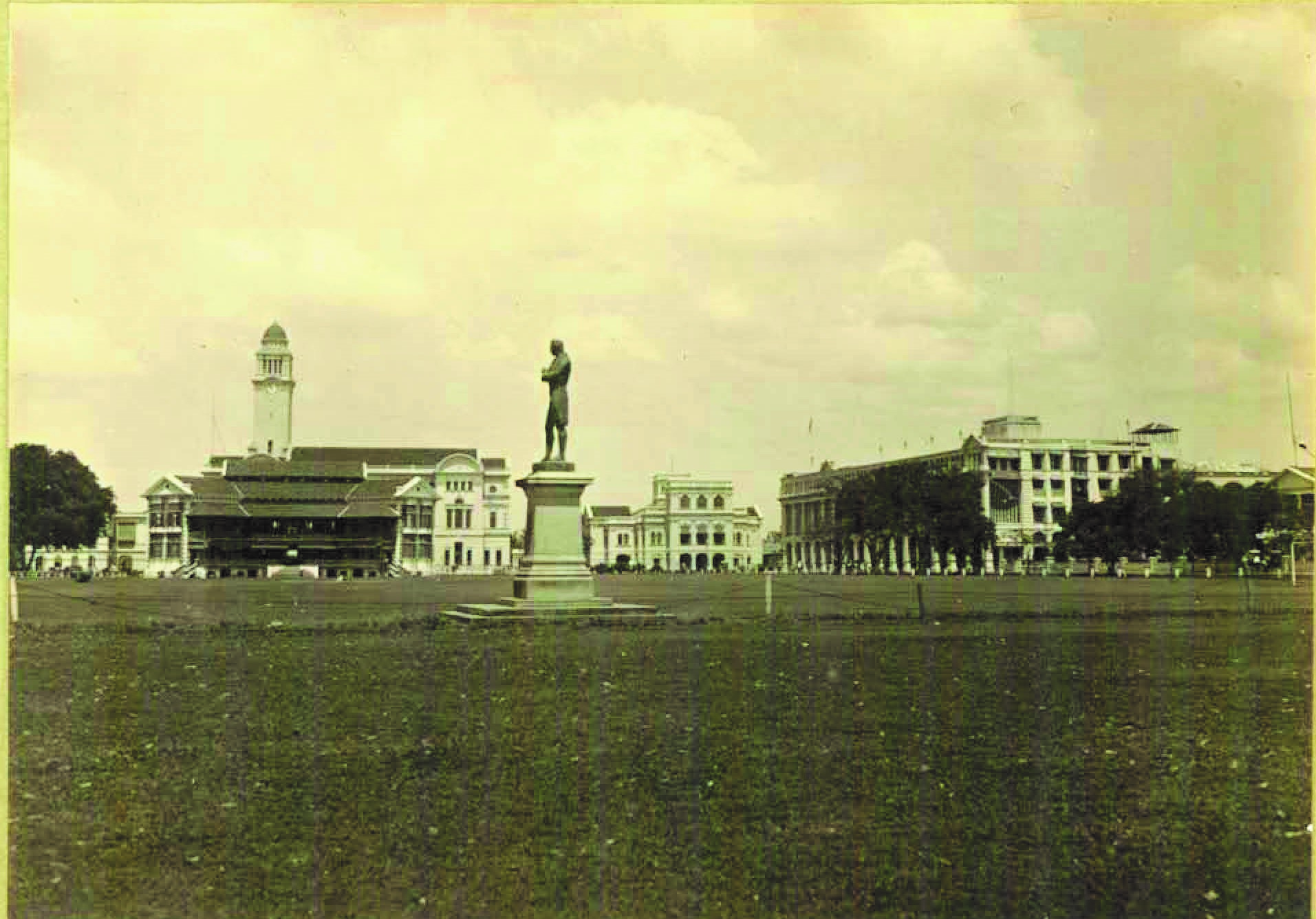
He also gives an interesting perspective on the Raffles Library’s standing during that era with an interesting emphasis on J.R. Logan’s collection of philological works:
Chapter Five offers descriptions of public buildings and places of interest, listing them alphabetically, many of which are no longer extant. They include the gaol which used to stand at the Sepoy Lines, Boustead Institute and the Chinese Protectorate. Others are of large spaces like Bukit Timah hill, the dockyards and the esplanade. Many of them are of government buildings and civic locations, although he does highlight unusual local buildings and sights such as the Shrine of Iskandar Khan and the Shrine of Habib Noh along with Whampoa’s garden.
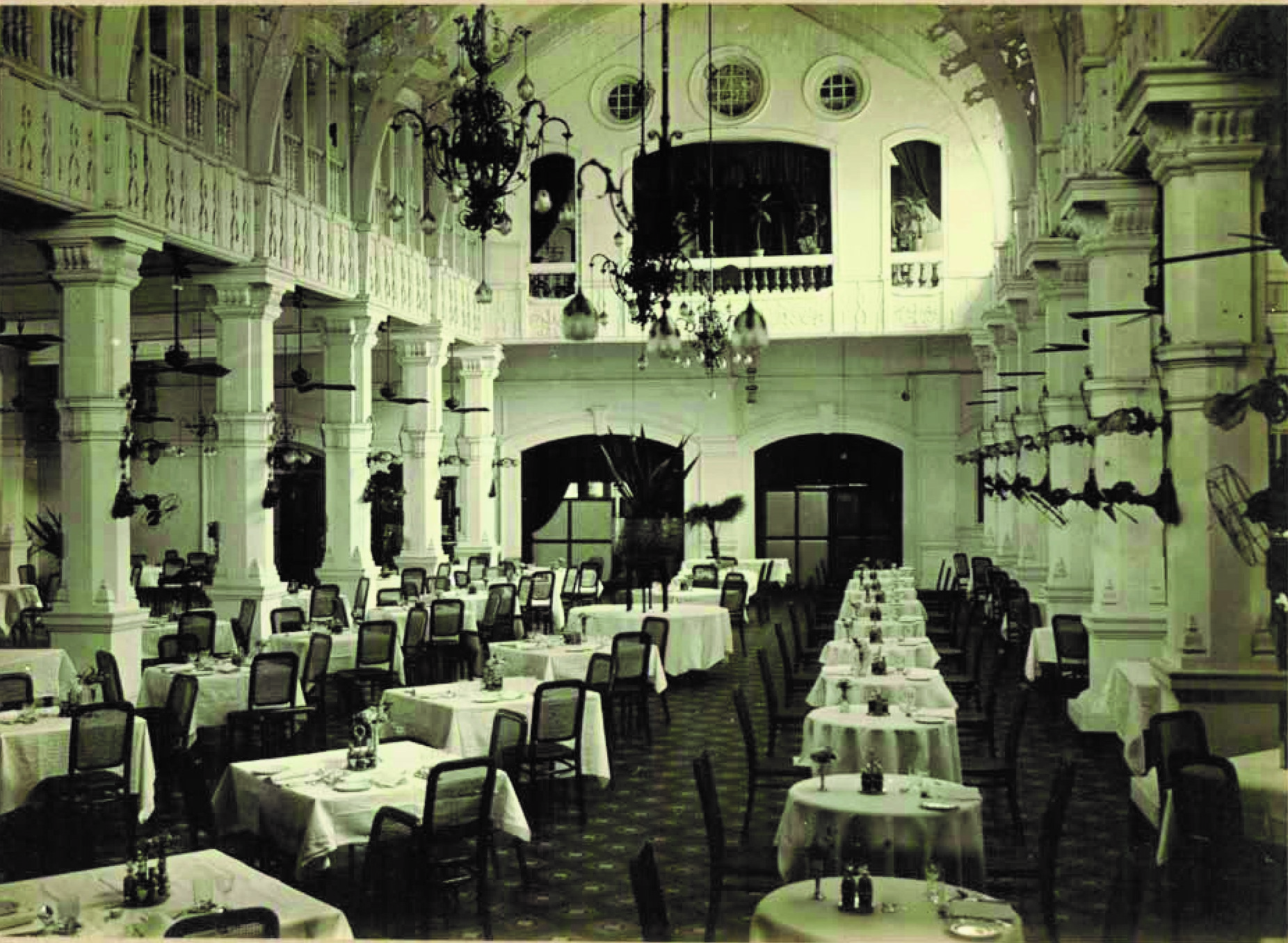
Other useful information such as a listing of clubs, societies, banks, consulates, religious buildings, hospitals, hotels and shops are also compiled in subsequent chapters. Of pragmatic importance are the rates for hiring private and hackney carriages, listed with tables of distance and relevant fares. The principal steamship lines and agents along with a listing of ports are given in a separate chapter. Statistical details of population, imports, exports, shipping and even weather conditions reflect the dynamics between trade and people in Singapore at the turn of the century. There is even a chapter on the fauna, flora and geology of the island. He credits W. Davison of the Raffles Library and Museum for his work on the fauna, and H.N. Ridley for his piece on the flora and geology of Singapore, both of which were published in his handbook.3
Colloquial Expressions
Throughout the text, Reith gives the colloquial place names mainly in Malay of colonial buildings and landmarks with footnotes giving pronunciation as well as English translations. A longer listing of Malay place names alongside their English names are given in Chapter 9, revealing how the locals viewed some of these colonial landmarks. For example, the Masonic Hall was known familiarly as “Rumah Hantu” (Reith, 1892, p. 90) or “Haunted House” and so the Methodist Episcopal Church that had just been established beside it was known as “Greja dekat Rumah Hantu” (Reith, 1892, p. 90) or the “church near by the Haunted House”. Also listed are Malay terms for giving directions to hackney carriage drivers such as “Turn the Carriage” – “Pusing kreta”, “Light the lamps” – “Pasang pelita (or Lampo)”, “Too much” – “Banyak chukup” and “Off with you!” – “Pulang!” (Reith, 1892, pp. 92–93). He concludes with advice to purchase the Malay Pronouncing Handbook, published in 1886, to better equip the visitor in communicating with the locals.
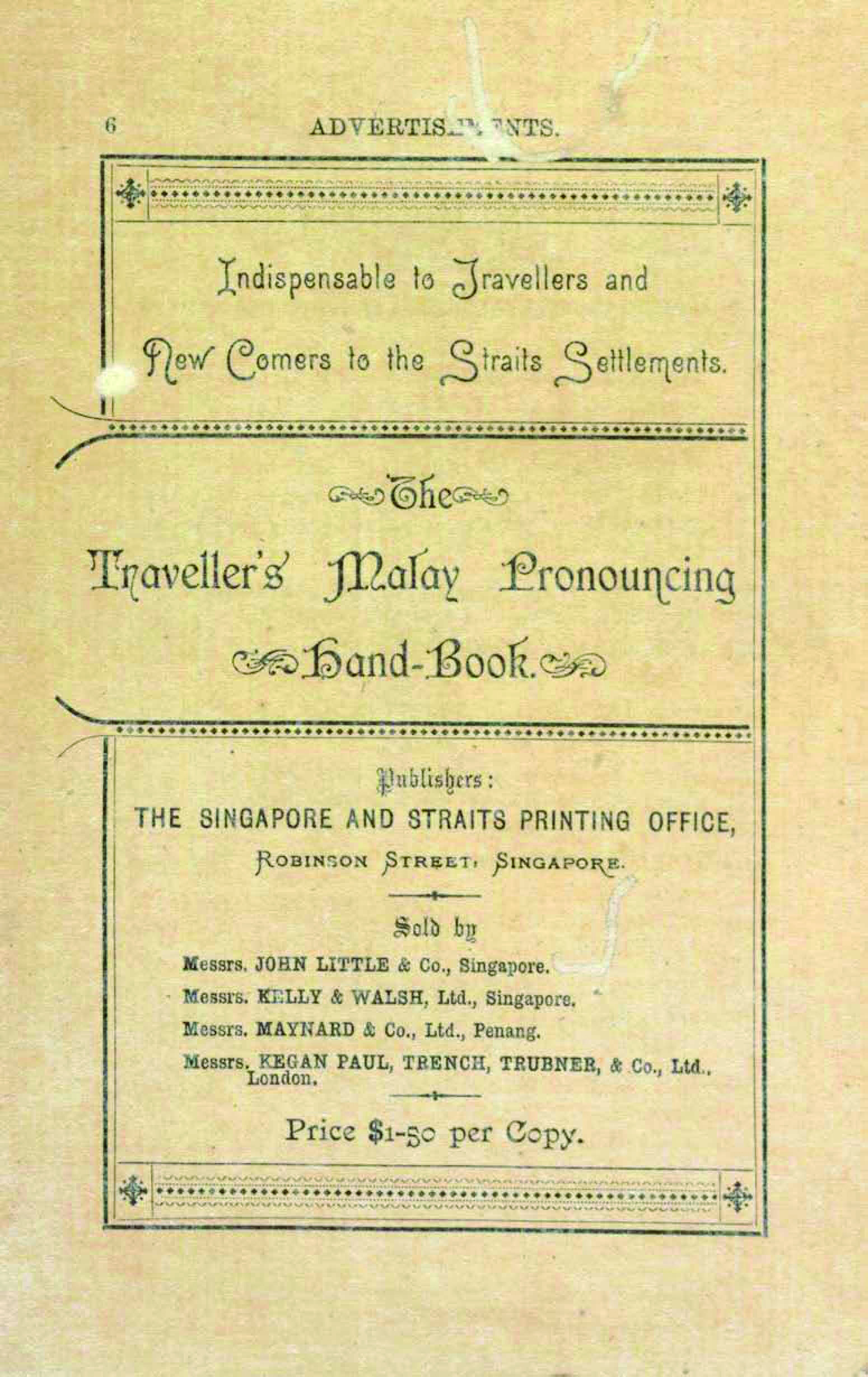
A full chapter, the last in the book, focuses on the Malay language and literature and was commended by Paul Kratoska in the introduction to the 1985 reprint as “a competent summary of the then current views on the Malay language” (Reith, 1985, p. v). Here, Reith reveals his appreciation for the poetic nuances found in local expressions:
Reith also introduces the reader to the wealth of Malay literature ranging from its dramatic legends to the profound truths found in pantuns (poems) while lamenting the loss of “a valuable collection of Malay manuscripts, made by Sir Stamford Raffles” (Reith, 1892, p. 133) when his ship went up in flames.
Illustrations and Advertisements
Although there are no sketches, photographs or illustrations, there is a useful map of Singapore with an accompanying index. Interestingly, a plan of the Botanical Gardens is also the only other illustrated panel in this publication. Unfortunately, the Library’s copy lacks the town map and plan of the gardens. Eleven pages of text-based advertisements end off the guide and show some aspects of the early companies and agencies that helped fuel the tourist trade.
Reprints, Reviews and Remiss
Reith had taken some pains to ensure that the published information was accurate although in the late 19th century, this had proved difficult. Even so, Reith had preempted a reprint of the guide saying: “it is hoped that future editions… will correct the errors that may have crept into this edition” (Reith, 1892, p. iii). Indeed, some 15 years later, Walter Makepeace would help update the guide, adding an extra chapter on the Federated Malay States and photographic plates of landmarks and sights in Singapore by G.R. Lambert, besides providing the most current statistical and informative data for 1907. This version of the guide remained highly valued with a reprint made in 1985 by Oxford Press with an insightful introduction by Paul Kratoska.
Mary Turnbull, in her review of the 1985 reprint summarises the handbook’s value succinctly, thus accounting for its repeated reprints across almost a century:
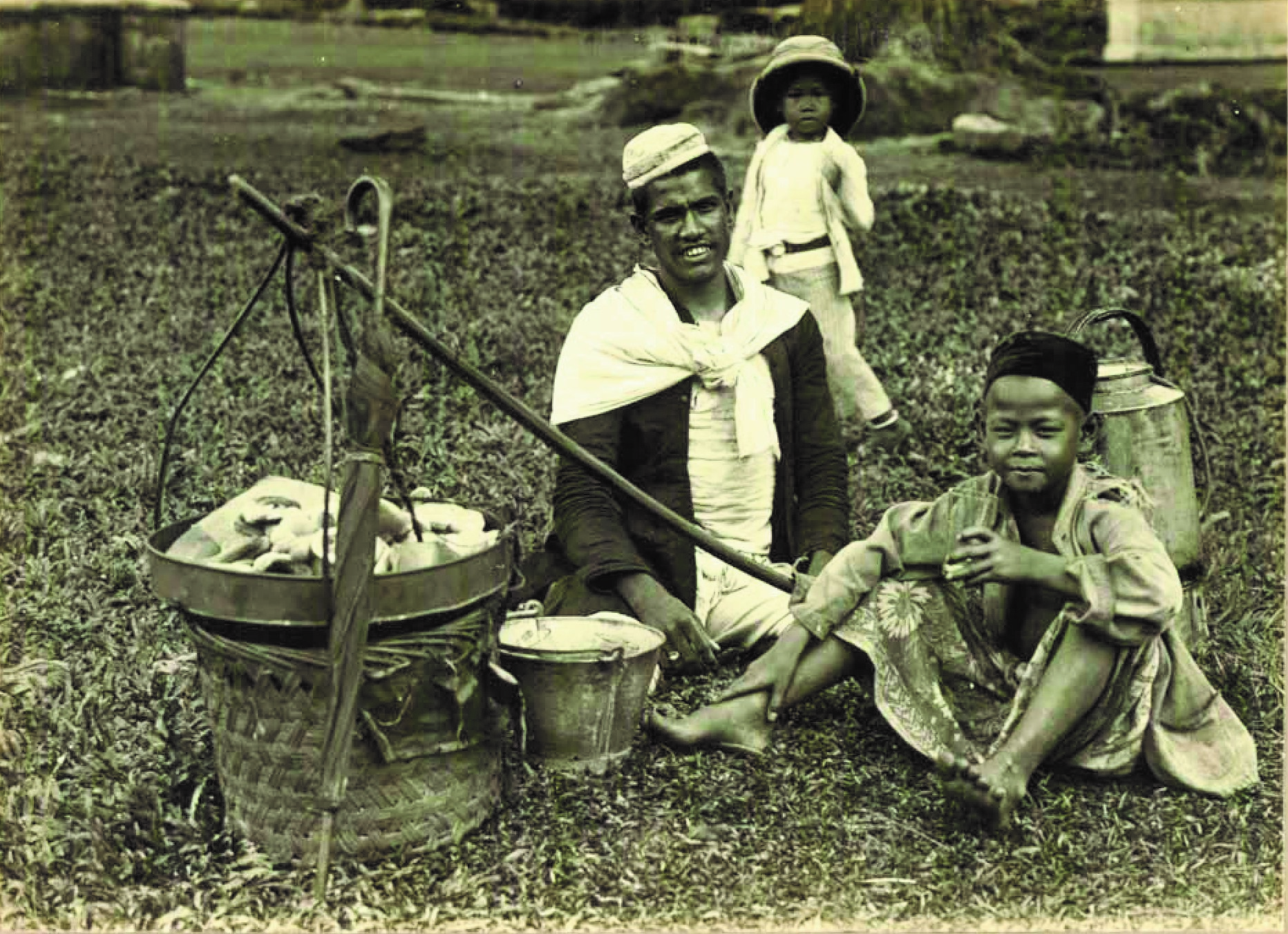
Kratoska, in his introduction to the 1985 reprint of the handbook, notes: “Something of the character of the late Victorian traveler can be seen from the information Reith provides and the sights he recommends. The attraction was not Asia but European activities and accomplishments in Asia, and the city’s main points of interest were the fruit of the Public Works Department’s art” (Reith, 1985, pp. v–vi). Turnbull, however, counters Kratoska’s criticism of the text as being Eurocentric by pointing out that “the guide was enterprising for its day in recommending strolls through the ‘native quarters’ and shopping forays into the ‘Thieves Market’ in Rochor” (Turnbull, 1988, p. 302).
Reith seemed aware of the cultural tightrope he walked when writing his guides and travelogues, and had published an open apology for any offence inadvertently made which he published in his subsequent book, Padre (1897):
And then as if to explain both why such offence is likely to be made by one especially from the British Isles, and how the Briton can sustain similar criticisms, he says:
Both Kratoska and Turnbull agree that the handbook is a child of its time – “a competent guide to a colonial city and a colonial way of life” (Reith, 1985, p. x) as well as offering “a justifiable pride in showing off the settlement to visitors” (Turnbull, 1988, p. 302). It was after all written from a British perspective for the Western tourist and we must read it with a Scotsman’s sense of humour!
The guidebook can be accessed on NL Online. The 1907 reprint by Walter Makepeace as well as the Oxford Press 1985 reprint are also available at the National Library. Photographic plates for this article were derived from the Souvenir of Singapore, 1914, which is also available on NL Online.
About George Murray Reith (1863, Aberdeen, Scotland–27 February 1948, Edinburgh)
Early Life
The eldest son of Dr Archibald Reith, George Murray obtained his MA at Aberdeen University in 1884 and furthered his education at New College, Edinburgh. He assisted at Dundee McCheyne Memorial before being ordained at the London Free Church Presbytery. Then he was sent to serve in Singapore in 1889 where he was made the minister of the local Presbyterian church in Singapore between 1889 and 1896.
Presbyterian Minister
He was the eighth minister appointed to the Presbyterian church since the founding of the local church in 1856. It came under the jurisdiction of the Presbytery of London (North) as many of the merchants who attended this church would retire to London. However, the church was always associated with the Scots who had formed the first congregation. The church building at Stamford Road was established more than a decade earlier in 1878 prior to Reith’s arrival. Ministers stayed between four and six years, so Reith’s term of about seven years was considered long. He preached at the Presbyterian church as well as the Boustead Institute each Sunday. Besides this, he also conducted monthly lectures on church history and biblical criticism along with special classes on the background to Scotland. He was unafraid to engage the authorities in controversial matters such as labouring on Sundays4 and the problems of gambling at the races. Nicknamed the Presbyterian padre, likely after his publication Padre in Partibus (1897), he was succeeded by Rev. S. Stephen Walker in 1896 after which Reith returned to Edinburgh in Scotland.
Community Contributions
As a parting gift, the community in Singapore gave him a silver ink stand – a sign of how his contribution to Singapore town was greatly appreciated. Besides serving as preacher and minister, he was also founder and the first secretary-treasurer of the Straits Philosophical Society which began in 1893. In addition, he was also a committee member of the Straits Settlements Association as well as the Straits Asiatic Society, Raffles Institution and Raffles Library. He also gave direction to the local Theological Society which held monthly meetings. He remained active in the community even after he left Singapore, contributing to the local press, writing particularly of the Scottish community until as late as 1910. Locally, he was most known for publishing the Handbook to Singapore in 1892, which was then revised by Walter Makepeace and republished in 1907. The later version was republished in 1985 by Oxford Press almost a century later.
Life in Scotland
Upon his return to Scotland, he was appointed minister to St Cuthbert’s United Free Church, Edinburgh, in 1898. He continued writing and served as editor of the Proceedings and Debates of the Free Church General Assembly in Great Britain from 1900. His poor health led him to resign from St Cuthbert in 1911 although he continued ministry serving as minister to Cumbernauld Baird United Free Church in Glasgow between 1916 and 1917.
Family
Father: Dr Archibald Reith, Aberdeen.
Sister: Mary Reith, eldest sister (b. 1865?–d. 25 March 1947). She had married James Moffatt, the learned theologian who became well known for his translation of the Bible.
Wife: May McNeill Bowie (m. 1907), daughter of Rev. John Sharp Bowie.
Sons: He had four sons.
G.M. Reith, A Padre in Partibus: Being Notes and Impressions of a Brief Holiday Tour Through Java, the Eastern Archipelago and Siam (Singapore: Singapore and Straits Print. Off., 1897). (Call no. RRARE 959.8022 REI; microfilm NL5829)
G.M. Reith, Handbook to Singapore: With Map and a Plan of the Botanic Gardens (Singapore: Singapore and Straits Print Office, 1892). (From BookSG; call no. RRARE 959.57 REI; microfilm NL7522)
G.M. Reith, “The Opium Problem in the Straits Settlements,”Transactions of the Straits Philosophical Society 1 (12 August 1893), 94. (Microfilm NL5718)
G.M Reith, The Breezy Pentlands (Edinburgh: T. and N Foulis, 1910)
G.M. Reith, Reminiscences of the United Free Church General Assembly (1900–1929) (London: The Moray Press, 1933)
Lim Boon Keng, The Chinese Crisis from Within (Singapore: Select Pub., 2006). (Call no. RRARE 951.04 LIM; microfilm no. NL24331)

Senior Librarian
Lee Kong Chian Reference Library
National Library
REFERENCES
Charles Burton Buckley, An Anecdotal History of Old Times in Singapore: (With Portraits and Illustrations) From the Foundation of the Settlement … on February 6th, 1819 to the Transfer to the Colonial Office … on April 1st, 1867, vols. 1 and 2 (Singapore: Fraser & Neave, 1902). (From BookSG; call no. RRARE 959.57 BUC; microfilm NL269)
B.E. D’Aranjo, Stranger’s Guide to Singapore With Maps (Singapore: Singapore Press, 1890). (From BookSG; call no. RRARE 959.57 DAR; microfilm NL2550)
C.M. Turnbull, “Reviewed Work(s): 1907 Handbook to Singapore by G. M. Reith,” The China Quarterly no. 114 (1988), 301–02. Retrieved from JSTOR via NLB’s eResources website.
“Deaths,” The Times, 26 March 1957, 1.
“Deaths,” The Times, 1 March 1948, 1.
“Ecclesiastical Intelligence,” The Times, 11 May 1901, 10.
G.M. Reith, Handbook to Singapore: With Map and a Plan of the Botanic Gardens (Singapore: Singapore and Straits Print Office, 1892). (From BookSG; call no. RRARE 959.57 REI; microfilm NL7522)
G.M. Reith, A Padre in Partibus: Being Notes and Impressions of a Brief Holiday Tour Through Java, the Eastern Archipelago and Siam (Singapore: Singapore and Straits Print. Off., 1897). (Call no. RRARE 959.8022 REI; microfilm NL5829)
G.M. Reith, Handbook to Singapore (Singapore: Oxford University Press, 1985). (Call no. RSING 959.57 REI)
H.T.S., “Padre’s Guide to Singapore Was the First Ever,” Straits Times, 1 October 1960, 6. (From NewspaperSG)
“Inventory Acc 3564 – Papers of the Rev George M. Reith,” National Library of Scotland, https://digital.nls.uk/catalogues/guide-to-manuscript-collections/inventories/acc3564.pdf
Irene Hoe, “Fascinating Flaws,” Straits Times, 10 August 1985, 2. (From NewspaperSG)
Max E. Fletcher, “The Suez Canal and World Shipping, 1869–1914,” The Journal of Economic History 18, no. 4 (December 1958), 556–73. Retrieved from JSTOR via NLB’s eResources website.
Obituary – Rev. Dr. J. Moffatt,” (1944, June 29). The Times, 29 June 1944, 7.
“Personalia 275,” The Aberdeen University Review 3, no. 7 (1915), 275, https://archive.org/details/aberdeenuniversi03univuoft/page/274/mode/2up
“Presbyterian Church Singapore,” Straits Times, 2 March 1893, 3. (From NewspaperSG)
“Presbyterian Church – Celebration of 50 Years of Work,” Straits Times, 2 March 1928, 11. (From NewspaperSG)
“Single Person Record Details: NA8646 George Murray Reith,” Scottish Archive Network, https://catalogue.nrscotland.gov.uk/scancatalogue/person.aspx?code=NA8646
[Souvenir of Singapore, 1914] (https://www.nlb.gov.sg/main/book-detail?cmsuuid=248b6b23-c39d-457a-8f06-bfd41c921231) ([S.l.: s.n.], 1914). (From BookSG; call no. RRARE 959.57 SOU; microfilm NL16348)
“The New Presbyterian Minister,” Singapore Free Press and Mercantile Advertiser, 25 April 1896, 2. (From NewspaperSG)
“The Presbyterian Church,” Straits Times, 4 July 1889, 2. (From NewspaperSG)
“The Presbyterian Church,” Singapore Free Press and Mercantile Advertiser, 27 April 1896, 2. (From NewspaperSG)
“The Rev. G. M. Reith,” Singapore Free Press and Mercantile Advertiser, 28 February 1896, 3. (From NewspaperSG)
“The Rev. G. M. Reith,” Singapore Free Press and Mercantile Advertiser, 21 February 1896, 2. (From NewspaperSG)
“The Rev. Mr. Reith,” Straits Times, 30 August 1897, 2. (From NewspaperSG)
“The Rev. Mr. Reith on Gambling,” Straits Times, 19 October 1891, 3. (From NewspaperSG)
“The Rev. Mr. Reith - Sunday Labour,” Straits Times, 21 September 1891, 2. (From NewspaperSG)
The Traveller’s Malay Pronouncing Hand-Book: For the Use of Travelers and Newcomers to Singapore (Singapore: Fraser & Neave, 1907). (Call no. RRARE 499.2883421 TRA)
NOTES
-
Library’s bibliographic record indicates “Imperfect copy”. ↩
-
It does however touch on early references to the island in Malay legend found in the Sejarah Melayu and in the Lusiad of Cameon – a Portuguese epic. ↩
-
Davison’s and Ridley’s articles are found in chapter 13, but Davison’s is an abridged version of the original. ↩
-
Reith argued against labour on Sunday despite the increase in wages. The matter was being discussed at the Colonial Office particularly among shipping firms, docks and mariners. “The Rev. Mr. Reith - Sunday Labour,” Straits Times, 21 September 1891, 2. (From NewspaperSG) ↩

